(ESP)
**La joya de Martin Scorsese **
Siempre ha existido un tipo de rivalidad entre las dos obras del Director, la disputa esta entre Taxi Driver y Toro Salvaje, no podemos negar que ambas son maravillas cinematográficas en todos los sentidos, en taxi driver aprendemos de como los colores y la composición fotográfica puede transmitir más que un parlamento entre dos personajes, de cómo la dirección de arte habla por sí sola, entre otros detalles. Pero de la película que hablare es de Toro Salvaje, una trama profunda y compleja de como nuestro personaje (Jake Lamota) es perturbado mientras va avanzando la película, a simple vista decimos que se trata de una película de boxeo más, pero no, el boxeo más bien queda como un simbolismo de todos los golpes que Jake se da con la vida. Solo veamos este primer fotograma con el cual comienza la película:
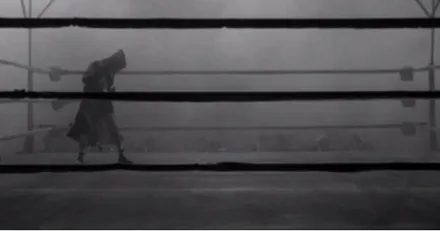
Vemos a un Jake solo, Dividido, oscuro. Ya con la primera escena Scorsese nos explica sin decir lo que pasara a lo largo de la trama, Jake está solo, tiene problemas con su familia, a pesar de que es un buen boxeador, pero no está lleno como persona, por eso en esta escena lo vemos boxeando solo, pelea consigo mismo, contra sus demonios y tener ese detalle es magnífico de parte del director.
El Guionista de esta película “Paul Schrader” (El mismo guionista de taxi driver) plantea una historia muy similar a la ya mencionada película, no en cuanto a trama del personaje, sino al contexto de la historia y como es típico del director haciendo criticas abundantes para la época, Machismo, maltrato a la mujer, drogas, etc. Destacando sobretodo la relación con su esposa.
Como explique anteriormente a simple vista creemos que la película se tratara de boxeo, peleas y sangre, pero la verdad es que el boxeo como explique queda en segundo plano pero lo más paradójico de todo esto, ya es opinión personal, es que es una película donde mejor nos hace sentir en el ring de pelea, nos hace sentir cada golpe, cada fracaso, la mezcla de sonido es espectacular, el sonido juega un papel importante destacando sobretodo la escena final de la película donde CADA golpe suena muy dramático, como espectadores nos hace sentir escalofríos, junto con los movimientos de cámara nos hace sentir dentro de una pelea real. Quisiera destacar una escena que me parece una genialidad y que es un buen recurso para adentrarnos más en la trama y su desarrollo.
Las peleas en la película son fuertes, Scorsese en esa época no se dedicaba a hacer mucha violencia por lo que podemos decir que en cierta forma era inexperto en ese aspecto, las peleas me parecen importantes, no por las secuencias sino por el significado que las mismas tienen
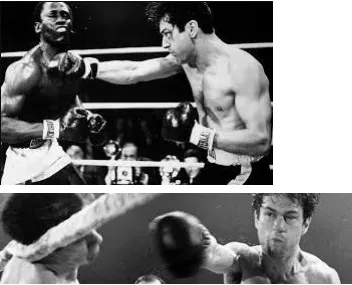
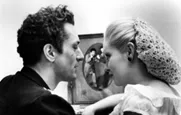
Las peleas reales no son las que desarrolla Lamotta en el cuadrilátero, sus verdaderas peleas son con su familia, especialmente con su esposa, aquí es donde entra una genialidad en cuanto a montaje y Guion, La única secuencia a color de toda la película.

Es una genialidad por parte del director hacer esto, nos transmite que no todo es blanco y negro, también hay colores, hay felicidad, no todo es malo y nuestras familias y amigos es todo lo que tenemos, no todo es lujo, la secuencia dura alrededor de 2 minutos y 30 segundos, en los cuales nos muestra lo que muchos describen como el MEJOR MONTAJE DE LA HISTORIA DEL CINE, una cámara totalmente en mano, dando a entender que los mismos personajes están grabando sus vidas, donde se van haciendo cortes entre las peleas de Jake que las vemos en blanco y negro y los momentos “A color” ¿Casualidad? ¿A caso es casualidad que únicamente las fotografías que se encuentran en blanco y negro es donde se ve a Jake peleando? ¿O es una idea muy original por parte del director retratar dos realidades completamente diferentes donde la vida de Jake es oscura y deprimente cuando se centra en el boxeo y cuando está feliz con su familia es color? Queda a libre entendimiento.
Hablemos de la historia de amor en la cual se centra la película, al escuchar esto decimos que es la historia entre Jake y su esposa, pero no. Es la Historia de Amor entre los dos hermanos, Jake y Joey, los dos protagonistas y como la historia de estos dos hermanos se separa por diversos motivos que los llevan a odiarse. El director va cociendo la historia de estos dos hermanos con la historia de esa segunda esposa del personaje de Jake que sufre abusos por parte de su esposo, formando así un triángulo dramático o un triángulo de conflicto en el cual se centra toda la historia. Una de las mejores escenas por destacar seria la alusión a la crucifixión de Jesús.
Hagamos un poco de historia del director, Scorsese creció en un ambiente muy religioso pues sus padres son devotos católicos. No es casualidad que Scorsese implemente una secuencia muy religiosa en su cinta como lo es esta, un claro guiño a la crucifixión de Jesús. Excelente por parte del director

¿Qué podemos decir de las angulaciones? Espectaculares es la única palabra que se me viene a la cabeza, no solo es una muestra visual y equilibrada por parte del director, sino que es una clase magistral de cómo se utilizan las angulaciones y que significado transmiten, veamos este ejemplo:
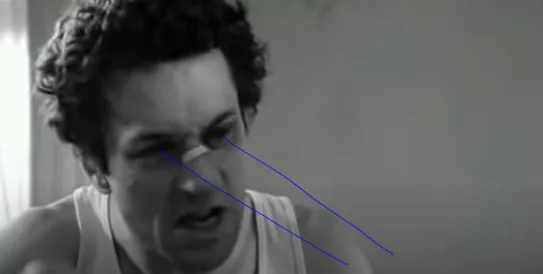
La mirada de Jake está completamente Picada, está observando a su hermano y pidiéndole que le golpee lo más fuerte posible, es decir que tenemos una angulación contrapicado del personaje de jake, ¿Qué provoca esto? Lo hace ver más desafiante, fuerte, imparable y poderoso, en algunas ocasiones en el film encontraremos este tipo de angulación hacia este personaje, en cambio al final de la película, no es así, se explicará más adelante, continuamos:
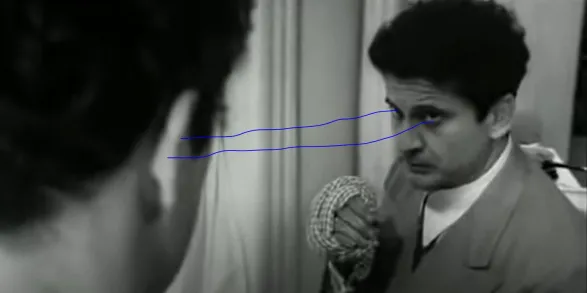
La mirada de Joey esta contrapicada, la forma en que observa a su hermano es casi de miedo, ¿Qué nos transmite? Inferioridad, sumisión y terror. Otro punto a destacar es el encuadre
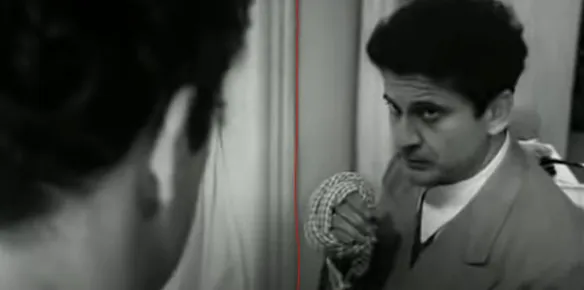
Esto habla del excelente trabajo del director al ver CADA detalle, podemos observar una línea imaginaria justamente en el medio de los dos personajes, a simple vista posiblemente no lo notemos, pero es una clara referencia a lo dividido que están los dos, además vemos como en el cuadro Jake parece una figura monstruosa, teniendo su cabeza como si se tratase de alguien imparable, abarcando mucho espacio en el encuadre.
Hablemos de una de las últimas escenas, la escena de la última pelea de Jake Lamotta
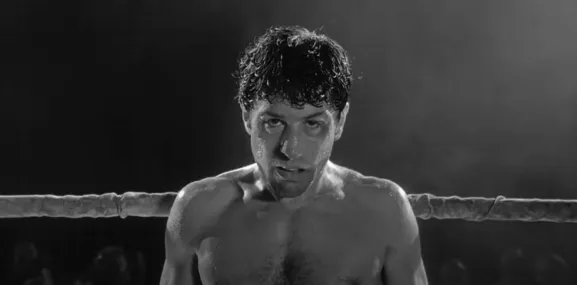
Increíble, todas las técnicas de sonido, composición, movimientos de cámara, etc, Están empleados en esta escena, observamos en este plano a un Jake centrado, esta acorralada, sabe que va a perder, esta contra las cuerdas y la derrota se aproxima. Tenemos estos acercamientos a sus piernas y una vez más, Scorsese retrata la crucifixión de Jesús. Planos cerrados dando más dramatismo a la secuencia
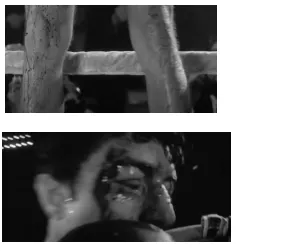
Un plano casi angelical de Robinson preparándose para lanza sus golpes a Lamotta, como si se tratase de un verdugo de la época medieval
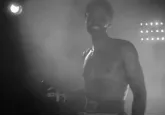
Por ultimo nos quedamos con este plano donde al fondo se escucha que la pelea ha sido ganada por Robinson, simbolizando toda la sangre que derramo para que al final termine perdiendo Todo lo que tuvo
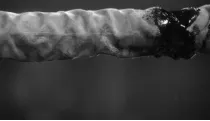
CONCLUSIÓN
Es una película que es una maravilla del cine, muy profunda y técnicamente espectacular, es digna de estudio, personalmente la he visto 3 veces y las 3 veces le encuentro detalles impresionantes, aunque como digo, todo es subjetivo, quizás son detalles apropósitos que el director los coloco para darle un significado a algún determinado objeto o plano, o a lo mejor es algo personal de cada crítico, cual sea la razón, todo tiene un porque, nada es al azar y creo que con toro salvaje ese es el caso. No es Valido decir que se trata de la mejor película del cine, ya que tenemos casos como ciudadano Kane, Centauros del desierto, Lawrence de Arabia, vértigo, Taxi Driver, etc. Pero sin duda esta entraría en un top 5 de las mejores, por todo lo anteriormente analizado, se debe de estudiar y comprender, para entender que es la cinematografía y como “CONTAR SIN DECIR”.
(ENG)
The jewel of Martin Scorsese
There has always been a type of rivalry between the two works of the Director, the dispute is between Taxi Driver and Toro Salvaje, we cannot deny that both are cinematographic wonders in every way, in taxi driver we learn about how colors and photographic composition can transmit more than a parliament between two characters, how the art direction speaks for itself, among other details. But the film I will talk about is Wild Bull, a deep and complex plot of how our character (Jake Lamota) is disturbed as the film progresses, at first glance we say that it is one more boxing film, but no, the boxing rather stands as a symbolism of all the blows that Jake takes with his life. Let's just look at this first frame with which the movie begins:

We see a single Jake, Divided, dark. With the first scene Scorsese explains to us without saying what will happen throughout the plot, Jake is alone, he has problems with his family, even though he is a good boxer, but he is not full as a person, that's why in this scene we see him boxing alone, he fights with himself, against his demons and having that detail is magnificent from the director.
The Screenwriter of this film "Paul Schrader" (The same taxi driver scriptwriter) poses a story very similar to the aforementioned film, not in terms of the character's plot, but in the context of the story and as is typical of the director making criticisms abundant for the time, machismo, mistreatment of women, drugs, etc. Highlighting above all the relationship with his wife.
As I explained above, at first glance, we believe that the film will be about boxing, fights and blood, but the truth is that boxing, as I explain, remains in the background but the most paradoxical of all this, is already personal opinion, is that it is a film where it makes us feel best in the fighting ring, it makes us feel each blow, each failure, the sound mix is spectacular, the sound plays an important role, especially highlighting the final scene of the film where EACH blow sounds very dramatic, as spectators it makes us feel chills, along with the camera movements it makes us feel inside of a real fight. I would like to highlight a scene that I think is a genius and that is a good resource to delve further into the plot and its development.
The fights in the film are strong, Scorsese at that time was not dedicated to doing much violence so we can say that in a way he was inexperienced in that aspect, the fights seem important to me, not because of the sequences but because of the meaning that them they have


The real fights are not those that Lamotta develops in the ring, his real fights are with his family, especially with his wife, this is where a genius comes in in terms of editing and Script, the only color sequence of the entire film.

It is a genius of the director to do this, he tells us that not everything is black and white, there are also colors, there is happiness, not everything is bad and our families and friends are all we have, not everything is luxury, the sequence lasts about 2 minutes and 30 seconds, in which he shows us what many describe as the BEST EDITING IN CINEMA HISTORY, a camera totally in hand, implying that the same characters are recording their lives, where cuts are made Between Jake's fights that we see in black and white and the "In color" moments. Coincidence? Is it by chance that only the photographs that are in black and white are where you see Jake fighting? Or is it a very original idea on the part of the director to portray two completely different realities where Jake's life is dark and depressing when he's focused on boxing and when he's happy with his family it's color? It is left to free understanding.
Let's talk about the love story in which the film is centered, when we listen to this we say that it is the story between Jake and his wife, but no. It is the Love Story between the two brothers, Jake and Joey, the two protagonists and how the story of these two brothers is separated for various reasons that lead them to hate each other. The director is cooking the story of these two brothers with the story of that second wife of the character of Jake who suffers abuse by her husband, thus forming a dramatic triangle or a triangle of conflict in which the whole story is centered. One of the best scenes to highlight would be the allusion to the crucifixion of Jesus.
Let's do a little history of the director, Scorsese grew up in a very religious environment as his parents are devout Catholics. It is no coincidence that Scorsese implements a very religious sequence in his film like this one, a clear nod to the crucifixion of Jesus. Excellent from the director

What can we say about the angulations? Spectacular is the only word that comes to mind, it is not only a visual and balanced sample by the director, but it is a master class on how angulations are used and what meaning they convey, let's see this example:

Jake's gaze is completely Picada, he is observing his brother and asking him to hit him as hard as possible, that is, we have a contrapic angle of Jake's character, what causes this? It makes him look more challenging, strong, unstoppable and powerful, on some occasions in the film we will find this type of angle towards this character, instead at the end of the film, it is not like that, it will be explained later, we continue:

Joey's gaze is misleading, the way he looks at his brother is almost scary, what does it convey to us? Inferiority, submission and terror. Another highlight is the framing
This speaks of the excellent work of the director when seeing EVERY detail, we can observe an imaginary line precisely in the middle of the two characters, with the naked eye we may not notice it, but it is a clear reference to how divided the two are, we also see how in the painting, Jake looks like a monstrous figure, holding his head as if it were someone unstoppable, taking up a lot of space in the frame.
Let's talk about one of the last scenes, the scene from Jake Lamotta's last fight
Incredible, all the sound techniques, composition, camera movements, etc., They are used in this scene, we observe in this shot a focused Jake, he is cornered, he knows he is going to lose, he is on the ropes and defeat is approaching. We have these close-ups of his legs and once again Scorsese portrays the crucifixion of Jesus. Closed shots giving more drama to the sequence

An almost angelic shot of Robinson preparing to launch his blows at Lamotta, as if he were an executioner from medieval times

Finally we are left with this shot where in the background you can hear that the fight has been won by Robinson, symbolizing all the blood that he spilled so that in the end he ends up losing Everything he had

CONCLUSION
It is a film that is a marvel of cinema, very deep and technically spectacular, it is worthy of study, I have personally seen it 3 times and all 3 times I find impressive details, although as I say, everything is subjective, perhaps they are details on purpose that the Director I place them to give a meaning to a certain object or shot, or maybe it is something personal to each critic, whatever the reason, everything has a why, nothing is random and I think that with wild bull that is the case. It is not valid to say that it is the best film in the cinema, since we have cases such as Citizen Kane, Centaurs of the desert, Lawrence of Arabia, vertigo, Taxi Driver, etc. But without a doubt this would enter a top 5 of the best, for everything previously analyzed, it must be studied and understood, to understand what cinematography is and how "COUNTING WITHOUT SAYING".